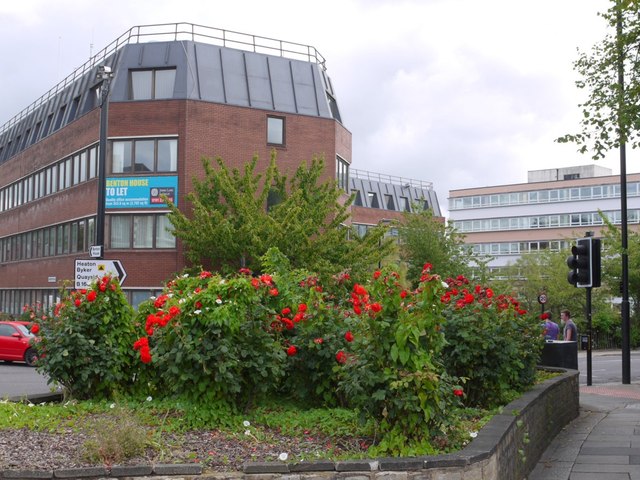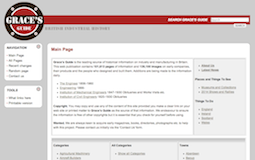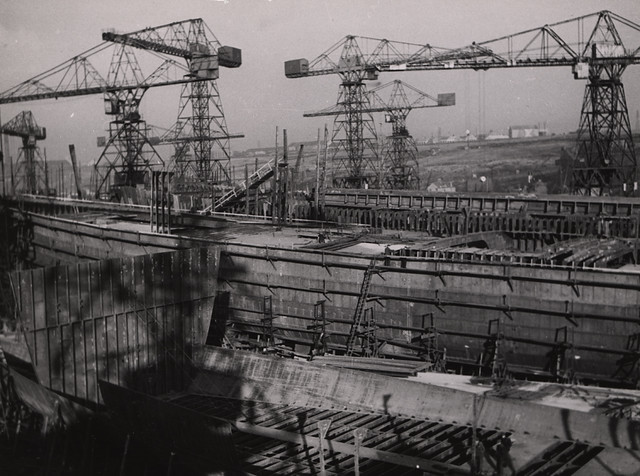Topics > Industry and Work > Ship Building > British Shipbuilders Corporation
British Shipbuilders Corporation
The Aircraft and Shipbuilding Industries Act 1977 resulted in the nationalisation of the major shipbuilding companies and the three large aviation companies in the UK. British Shipbuilders Corporation was the public corporation which owned and managed the UK shipbuilding industry from 1977 up to its privatisation under the terms of the British Shipbuilders Act 1983. The public corporation for the aviation companies was British Aerospace (BAE). British Shipbuilders Corporation incorporated 32 shipyards, 6 marine engine works and 6 general engineering plants around the UK. Its headquaters was in Benton House, on Sandyford Road in Newcastle. In 1977 the corporation's workforce was around 87,000; dropping to 62,000 by 1982.
British Shipbuilders Corporation (BS) was a public corporation that owned and managed the shipbuilding industry in Great Britain from 1977 through the 1980s. The British Shipbuilders Corporation headquarters was at Benton House in Newcastle upon Tyne, England.
History
The corporation was founded as a result of the Aircraft and Shipbuilding Industries Act 1977, which nationalised 27 major shipbuilding and marine engineering companies in Great Britain. A further 6 ship repair companies and a further shipyard were also acquired by the corporation, with British Shipbuilders initially comprising 32 shipyards, 6 marine engine works and 6 general engineering plants. Collectively, British Shipbuilders accounted for 97% of the UK's merchant shipbuilding capacity, 100% of its warship-building capacity, 100% of slow speed diesel engine manufacturing and approximately 50% of ship-repair capacity. Harland & Wolff, the only shipbuilder based in Northern Ireland was deemed to be a special political case and remained out of the control of the British Shipbuilders' management, despite it also being in state ownership from 1977.
The same act nationalised the three large UK aerospace companies and grouped them in an analogous corporation, British Aerospace.
Leadership and organisation
The first Chairman of British Shipbuilders, serving from 1978 to 1980, was Admiral Sir Anthony Griffin. He was succeeded by Sir Robert Atkinson, who in turn was succeeded by Graham Day in 1984, Phillip Hares in 1986, with the final Chairman, John Lister, taking office in 1987.
The company was initially organised into four operating divisions: Merchant, Naval, Ship-repair, Marine Engineering and General Engineering. This was restructured into five trading divisions in 1980: Merchant Shipbuilding, Warship-building, Engineering, Ship-repair and Offshore.
List of Chairmen
- Admiral Sir Anthony Griffin (1978 to 1980)
- Sir Robert Atkinson (1980 to 1984)
- Sir Graham Day (1984 to 1986)
- Phillip Hares (1986 to 1987)
- John Lister (1987 to 1989)
Privatisation
By the end of 1982, British Shipbuilders had closed half of its shipyards in an effort to reduce over-capacity. The terms of the British Shipbuilders Act 1983 then required the company to begin a process of privatising its remaining assets. The various divisions that had remained under integrated nationalised ownership were divested throughout the 1980s as the company wound up operations. The profitable warship-builders were sold off initially, with the merchant shipyards sold off or closed on a piecemeal basis, culminating in the sale of Govan Shipbuilders to Kvaerner in 1988 and Ferguson Shipbuilders to the privatised marine engine builder, Clark Kincaid, in January 1989. British Shipbuilders finally ceased active shipbuilding operations in 1989, with the closure of its last shipyards; North East Shipbuilders Ltd.'s Pallion and Southwick Shipyards at Sunderland. The remaining assets of North East Shipbuilders Ltd. were then privatised.
Abolition
The British Shipbuilders Corporation continued to exist as a 'shell corporation' in statute, in order to be accountable for any liabilities incurred during its operational history, until it was abolished in 2013 as part of the Government's 2010 public bodies reforms. From March 2013 any remaining liabilities of British Shipbuilders passed to the Department for Business, Innovation and Skills.
Assets subsumed by British Shipbuilders
The assets of the following companies vested in British Shipbuilders on 1 September 1977.
Shipbuilders and ship repairers
- Ailsa Shipbuilding Company, Troon (acquired in 1978, merged with Ferguson Shipbuilders in 1981 to form Ferguson-Ailsa)
- Appledore Shipbuilders, Appledore
- Austin & Pickersgill, Sunderland
- Brooke Marine, Lowestoft
- Cammell Laird Shipbuilders, Birkenhead
- Clelands Shipbuilding Company, Wallsend
- Falmouth Docks Company, Falmouth
- Ferguson Shipbuilders, Port Glasgow (initially a subsidiary of Scott Lithgow, merged with Ailsa in 1981 to form Ferguson-Ailsa)
- Goole Shipbuilding & Repairing Company, Goole
- Govan Shipbuilders, Govan, Glasgow (incorporating Scotstoun Marine Ltd)
- Hall, Russell & Company, Aberdeen
- River Thames Ship Repairers, Blackwall (later renamed Blackwall Engineering)
- Robb Caledon Shipbuilders, (comprising Henry Robb, Leith and Caledon Shipbuilding & Engineering Company, Dundee)
- Scott Lithgow, Greenock (comprising Scotts Shipbuilding and Engineering Company & Lithgows)
- Smiths Dock Company, Middlesbrough
- Sunderland Shipbuilders, Sunderland (incorporating William Doxford & Sons, Pallion)
- Swan Hunter Shipbuilders Limited, Wallsend (later renamed Swan Hunter) - also incorporating John Readhead & Sons, South Shields, Wallsend Slipway and Engineering Company, Wallsend and Grangemouth Dockyard Company
- Vickers Limited Shipbuilding Group, Barrow in Furness (renamed Vickers Shipbuilding and Engineering Limited - VSEL)
- Vosper Thornycroft, Woolston and Portsmouth
- Yarrow Shipbuilders (YSL), Scotstoun, Glasgow
Marine diesel engine manufacturers
- Barclay Curle and Company, Whiteinch, Glasgow
- George Clark & NEM, Sunderland
- Hawthorn Leslie and Company, Hebburn
- John G. Kincaid & Company, Greenock
- Scotts’ Engineering Company Limited, Greenock
Note: Harland and Wolff, Belfast was state-owned but did not form part of British Shipbuilders.
Denationalisation
This transport-related list is incomplete; you can help by expanding it.
- Scott Lithgow (Offshore Division) - 1981 - individual operating companies dissolved, sold to Trafalgar House in 1984, closed 1993.
- Brooke Marine (Merchant Division) - management buyout in 1985.[5][6] Ceased trading in 1992.
- Vosper Thornycroft (Warship Division) - 1985 - management buyout, known as VT Group until 2008, now BAE Systems Surface Ships.
- Yarrow Shipbuilders (Warship Division) - 1985 - sold to GEC-Marconi as Marconi Marine (YSL) then to BAE Systems as part of BAE Systems Marine, now BAE Systems Surface Ships.
- VSEL (Warship Division) - 1986 - employee buyout, with Cammell Laird as a subsidiary. Acquired by GEC-Marconi in 1995 as part of Marconi Marine, then to BAE Systems as part of BAE Systems Marine, now BAE Systems Submarine Solutions.
- Cammell Laird (Warship Division) - 1986 - as a subsidiary of VSEL, finished shipbuilding in 1993, now ship-repair firm.
- Ailsa Shipbuilders (Merchant Division) - 1986 - Ailsa split from merged BS subsidiary Ferguson-Ailsa and sold to Perth Corporation as Ailsa Perth Shipbuilders. Ceased shipbuilding in 1988.
- Hall Russell (Warship Division) - 1986 - management buyout, later acquired by A&P Appledore International in 1989, closed 1992.
- Swan Hunter (Warship Division) - 1987 - management buyout, entered receivership 1994, bought by Jaap Kroese. Ceased shipbuilding, 2006.
- Govan Shipbuilders (Merchant Division) - 1988 - sold to Kværner as Kvaerner Govan, to GEC-Marconi 1999 as part of Marconi Marine then to BAE Systems as part of BAE Systems Marine, now BAE Systems Surface Ships.
- Ferguson Shipbuilders (Merchant Division) - 1986 - Ferguson split from merged BS subsidiary Ferguson-Ailsa and merged with Appledore Shipbuilders to form new BS subsidiary Appledore-Ferguson. Ferguson Shipbuilders sold to Clark Kincaid (HLD Group) in 1989.
- Appledore Shipbuilders (Merchant Division) - 1986 - merged with Ferguson Shipbuilders to form new BS subsidiary Appledore-Ferguson. Sold to privatised North East Shipbuilders Ltd. to form A&P Appledore International in 1989.
- Clark Kincaid (Engineering Division) - 1989 - management buyout (HLD Group), later acquired by Kvaerner in 1990. Kvaerner Kincaid sold to Scandiaverken in 1999 and ceased manufacturing in 2000.
Visit the page: British Shipbuilders for references and further details. You can contribute to this article on Wikipedia.

from Geograph (geograph)
Office buildings, corner of Portland Road & Sandyford Road
Pinned by Simon Cotterill

from http://www.gracesguide.co.uk/…
British Shipbuilders
- "British Shipbuilders Corporation was a public corporation that owned and managed the UK shipbuilding industry from 1977 and through the 1980s.
1977 The corporation was founded as a result of …
Added by
Simon Cotterill

from https://en.wikipedia.org/wiki…
British Shipbuilders
- "British Shipbuilders Corporation (BS) was a public corporation that owned and managed the shipbuilding industry in Great Britain from 1977 through the 1980s. The British Shipbuilders Corporation headquarters was at …
Added by
Simon Cotterill

from http://www.nationalarchives.g…
The Geddes Committee and nationalisation
- "With the rise of foreign registration under 'Flags of Convenience' in the 1960s, the market for ships changed. A large proportion of ships built in Britain were registered in foreign …
Added by
Simon Cotterill

Co-Curate Page
Swan Hunter
- Overview History Swan Hunter was one of the best known shipbuilding companies in the world, founded in 1880 and based in Wallsend, by the River Tyne. After a merger with …


from Geograph (geograph)
Office buildings, corner of Portland Road & Sandyford Road
Pinned by Simon Cotterill

from http://www.gracesguide.co.uk/…
British Shipbuilders
- "British Shipbuilders Corporation was a public corporation that owned and managed the UK shipbuilding industry from 1977 and through the 1980s.
1977 The corporation was founded as a result of …
Added by
Simon Cotterill

from https://en.wikipedia.org/wiki…
British Shipbuilders
- "British Shipbuilders Corporation (BS) was a public corporation that owned and managed the shipbuilding industry in Great Britain from 1977 through the 1980s. The British Shipbuilders Corporation headquarters was at …
Added by
Simon Cotterill

from http://www.nationalarchives.g…
The Geddes Committee and nationalisation
- "With the rise of foreign registration under 'Flags of Convenience' in the 1960s, the market for ships changed. A large proportion of ships built in Britain were registered in foreign …
Added by
Simon Cotterill







